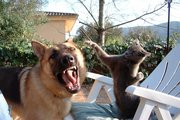German Shepherd Dog
|
|
| German Shepherd Dog | |||||||||||||||||||||
|---|---|---|---|---|---|---|---|---|---|---|---|---|---|---|---|---|---|---|---|---|---|
| Country of origin | |||||||||||||||||||||
| Germany | |||||||||||||||||||||
| Classification and breed standards | |||||||||||||||||||||
|
The German Shepherd Dog is an intelligent breed of dog. Because they are eager to please, they are easily trained in obedience and protection. German Shepherd Dogs are often used as working dogs in many capacities, including search and rescue (SAR), military, police or guard dogs. They are also used as assistance dogs / service dogs (such as guide dogs), though not as much as Labrador Retrievers and Golden Retrievers.
Appearance
The German Shepherd is a large, strong, substantial-looking dog. It varies in colour, coming in many different shades, mostly cream (tan) and brown.
White coat
A white (or very light), but not albino, version of the the German Shepherd has also always occurred, but was designated a disqualifying fault in the AKC in the late 1960s. This fault, however, does not prevent the white coated German Shepherd Dog from being registered in the AKC as a German Shepherd Dog. There are still fanciers of the German Shepherd breed who work to preserve the white coated German Shepherd Dog. See WGSDCA (http://www.wgsdca.org) for more detail. However, the white German Shepherd has been recognised by some organisations under the name Berger Blanc Suisse (or White Shepherd Dog).
Long-haired coat
The so-called "long-haired German Shepherd" is considered a "fault" in the German Shepherd Dog standard, according to the AKC. The long hair gene is recessive. Dogs with this coat look somewhat like the Tervueren type of Belgian Shepherd Dog. An example with pictures can be found here (http://www.leerburg.com/longhair.htm).
Giant shepherd
Some organizations recognize a deliberately bred, larger variation of the breed as the Shiloh Shepherd Dog or other names.
Breed Lines
There are several types or lines of GSD and the behavior, abilities, and appearance of each is quite different. The major lines are the international working line, the international show line, and the North American show line.
Dogs from working lines are bred primarily for traits involving their working ability rather than appearance, so their appearance can be somewhat varied.
The international show lines differ in that emphasis is given more to the appearance of the dog when breeding, so they are very consistent in type or appearance.
The North American show lines have also been bred primarily for their looks, but have a markedly different appearance from the international dogs, featuring a noticably sloped back and sharp angulation of the hock joint. There is a current debate over whether the American show lines still represent the original German Shepherd Dog, or whether the line has become distinct enough that it should be considered a separate breed. Critics of the American line argue that the working ability of these dogs has been lost, and that the angled back is detrimental to the health of the animal. Proponents of the line believe that the altered bone structure of their dogs represents an improvement to the herding ability of the animals.
Temperament
Well-bred GSDs have powerful jaws and strong teeth, can develop a strong sense of loyalty and obedience, and can be trained to attack and release on command. Poorly bred GSDs such as those from puppy mills can be fearful, overly aggressive, or both. The common misconception that GSDs are inherently violent is due most often to poor training.
Temperament Differences Among Lines
The different types or lines of GSD display differences not only in appearance but also in ability and temperament.
Dogs from working lines have very high energy, and have been bred to have a natural drive for protection, tracking, and obedience. They are bred primarily for consistent temperament, working drive, and intelligence. These dogs can be used as pets, but will be unhappy if not exercised daily or trained to do a job of some sort.
The international and North American show lines tend to have less energy and less working ability. These dogs can make excellent pets, provided that a poor breeder has not sacrificed consistent temperament or health in the quest for good looks.
Health
As is common in many large breeds, German Shepherds are prone to elbow and hip dysplasia. Other health problems sometimes occurring in the breed are von Willebrand's disease and skin allergies. German Shepherds are also prone to bloat. They have an average lifespan of twelve years.
History
The breed was originated by Captain Max von Stephanitz in the late 1800s and early 1900s. His goal was to breed an all-purpose working dog. Von Stephanitz admired the landrace herding dogs of his native Germany, and believed they had the potential to be all-purpose working dogs. Additionally, he was aware of the declining need for herding dogs and believed that the working abilities of the breed would decline unless it was put to other uses. Von Stephanitz created the Verein f?tsche Sch䦥rhunde, or SV as the official governing body for the breed. The SV then created the schutzhund trial as a breed test for the German Shepherd Dog, and prohibited the breeding of any dog which could not pass the trial. The schutzhund trial, along with the SV's conviction that "German Shepherd breeding is working dog breeding, or it is not German Shepherd breeding" led to a rapid development of the breed's abilities. After WWI, British and American soldiers, impressed by the abilities of the dog, brought home examples to breed. The breed instantly become popular, both as a family pet and as a working dog. To this day, the German Shepherd Dog is considered one of, if not the most intelligent and versatile breeds in existence.
Breed names
The proper English name for the breed is German Shepherd Dog (a literal translation from the German "Deutscher Sch䦥rhund") but they are usually informally referred to as GSD's or simply German Shepherds. Alsatian is also commonly used in the UK (the reason for the alternative name is historical: during World Wars I and II, Germany was out of favour in the UK and many German names were translated or anglicised).
Miscellaneous
German Shepherds often compete and excel in obedience trials and Schutzhund competitions. German Shepherds are also often trained as police dogs, due to their trainability, size and work drive.
Dog Pictures and Clipart
- Pictures of Dogs (http://classroomclipart.com/cgi-bin/kids/imageFolio.cgi?direct=Animals/Dogs)
- Dog Clipart (http://classroomclipart.com/cgi-bin/kids/imageFolio.cgi?direct=Clipart/Animals/Dog_Clipart)
Clipart and Animal Pictures
- Clipart (https://classroomclipart.com/image/category/clipart.htm)
- Animal Clipart (https://classroomclipart.com/image/category/animal-clipart.htm)
- Animal Animated Clipart (https://classroomclipart.com/clipart/Animations/Animals.htm)
- Pictures of Animals (https://classroomclipart.com/image/category/animal-photos.htm)
- Amphibian Clip Art, Pictures and Photogaphs (https://classroomclipart.com/image/category/amphibian-clipart.htm)
- Farm Animal Clip Art, Pictures and Photographs (https://classroomclipart.com/image/category/farm-animal-clipart.htm)
- Mammal Clip Art, Pictures and Photographs (https://classroomclipart.com/image/category/mammal-clipart.htm)
- Marine Animal Clip Art, Pictures and Photographs (https://classroomclipart.com/image/category/marine-life-clipart.htm)
- Reptile Clip Art, Pictures and Photographs (https://classroomclipart.com/image/category/reptile-clipart.htm)
- Spider Clip Art, Pictures and Photographs (https://classroomclipart.com/image/category/spider-clipart.htm)




